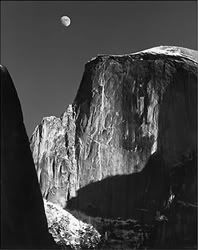 |  |
Right: Dogwood Blossoms, Ansel Adams, 1938
Here is a long and illuminating article about black-and-white films. The author says that some of the most memorable films are in black-and-white.
It is true that in photography, no nature study in color can equal the majesty and poetry of Ansel Adams' black-and-white work. While color sceneries can be spectacular, it is the black-and-white ones that are exquisitely beautiful. It is the same with portraits. Imagine all those Hollywood stars whose portraits were taken in black-and-white, and look at what we have now in the era of color.
I haven't had much time to think about this, but what I think is happening is that black-and-white is about poetry and the subliminal. Nothing in nature is black-and-white, therefore the photographer and cinematographer has to aim for something else besides replication, and go for representation instead. He therefore has to convince his audience of the authenticity of his work. Thus black-and-white photographs and films require more of the artist, since simple realism (replication) will not work. The photographer or the filmmaker has to compose the work, requiring him to do more than just clicking the shutter speed. That is why those studio portraits of movie stars are of such high quality, compared to what we get of the flashy, superfluously quick color shots of our modern-day "celebrities."
It is the same with paintings. However close to nature oil and water color pieces come, they are not replicas of that nature. The artist, like in black-and-white works, has to recreate his piece with his less-than-perfect medium. This strain on the artist is actually what makes great art. He leaves a trace of something other than the subject in these pieces - it could be the artist's presence that we feel, or God's, or as in poetry, something sublime and enigmatic. The artist's vision, however he comes by it, becomes part of the piece.
The writer of this article goes through almost all the genres of cinema - Westerns, Musicals, Comedies, Film Noir - and he very successfully argues that no color film can be compared to the best of these black-and-white films.
I agree with him. The flickering of the silver light, the high contrasts, the shadows, and the ethereal quality of the celluloid (which I especially appreciate since I've worked directly with black-and-white film strips) is a pleasure to behold.
It may be hard to get used to at the beginning, given our inundation with color. But there was no aesthetic reason for the switch to color other than that the technology became available, so, a switch to black-and-white is ultimately very fulfilling. And fortunately, as the author of the article states, there are plenty of places, from the internet to the Turner Classic Movie Channel, to find the black-and-white classics.